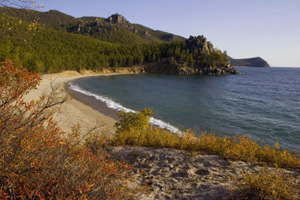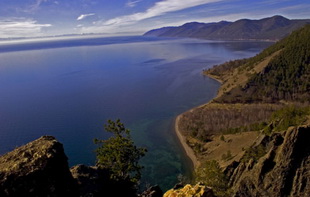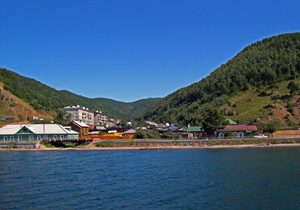Lake Baikal is in a rift valley created by the Baikal Rift Zone, where the
 crust of the earth is pulling apart. At 636 kilometers long and 79 kilometers
wide, Lake Baikal has the largest surface area of any freshwater lake in Asia
(31,494 skm) and is the deepest lake in the world (1,637 m). The bottom of the
lake is 1,371 metres below sea level, but below this lies some 7 kilometers of
sediment. In geological terms, the rift is young and active-it widens about two
centimeters per year. The fault zone is also seismically active: there are hot
springs in the area and notable earthquakes every few years. It drains into the
Angara tributary of the Yenisei.
crust of the earth is pulling apart. At 636 kilometers long and 79 kilometers
wide, Lake Baikal has the largest surface area of any freshwater lake in Asia
(31,494 skm) and is the deepest lake in the world (1,637 m). The bottom of the
lake is 1,371 metres below sea level, but below this lies some 7 kilometers of
sediment. In geological terms, the rift is young and active-it widens about two
centimeters per year. The fault zone is also seismically active: there are hot
springs in the area and notable earthquakes every few years. It drains into the
Angara tributary of the Yenisei.
Its age is estimated at 25-30 million years, making it one of the most ancient
lakes in geological history. It is unique among large, high-latitude lakes in
that its sediments have not been scoured by overriding continental ice sheets.
US and Russian studies of core sediment in the 1990s provide a detailed record
of climatic variation over the past 250,000 years. Longer and deeper sediment
cores are expected in the near future. Lake Baikal is furthermore the only
confined fresh water lake in which direct and indirect evidence of gas hydrates exists.
The lake is completely surrounded by mountains. The Baikal Mountains on the
north shore and the taiga are technically protected as a national park.
It contains 22 islands; the largest, Olkhon, is 72 kilometers long. The lake
is fed by as many as three hundred and thirty inflowing rivers. The main ones
draining directly into Baikal are the Selenga River, the Barguzin River, the
Upper Angara River etc. It is drained through a single outlet, the Angara River, where Listvyanka is situated.
Baikal's coastline stretches for over 1300 miles. Surprisingly,
wouldn't it be easier for us to imagine hundreds of thousands miles in the spatial
emptiness on the way to the moon than these thirteen hundred miles in majestic
 and live beauty open for hiking and unhurried views. Nonetheless, one is unable
to contain all these pictures within oneself. They are greater more beautiful,
more varied and amazing than we are capable of comprehending with our understandings
and senses. That can only be believed, unlike the astronomic distances to heavenly
bodies.
and live beauty open for hiking and unhurried views. Nonetheless, one is unable
to contain all these pictures within oneself. They are greater more beautiful,
more varied and amazing than we are capable of comprehending with our understandings
and senses. That can only be believed, unlike the astronomic distances to heavenly
bodies.
This has to be believed as well as Baikal basin's volume does ( 5520 cubic miles,
20 percent of all freshwater on the earth surface); the depth of its bed-load
deposits do ( up to 4-5 miles); the number of its water and coastline dwellers
do ( hundreds and hundreds of endemic animals and plants absent anywhere else
in the world); and a lot more of other things which are hard to believe.
Listvyanka

The small but tourist-wise town of Listvyanka is located on the south-western shore of
Lake Baikal, 70 km from Irkutsk. Russian pioneers came to this spot in the middle
of the 17th century, founded trading and military post there. The
settlement grew along with the development of navigation on Lake Baikal. Many vessels were built
at the Listvyanka shipyard, the British icebreakers "Baikal" and "Angara" were assembled also there. This
old-style Siberian village, known as the gates to Baikal, is situated at the
source of the Angara River, the only outflow of the deepest lake. From
the 18th century a ferry took merchants across the lake on their way to the
north, Mongolia, China and the Far East.
The population of the town is about 2,300 people, mostly employed in human services.
Despite its modest size Listvyanka is one of the busiest tourist centers in
Siberia. Due to its proximity to Irkutsk, it sees probably more
visitors than all other towns and villages on Lake Baikal combined - particularly
on the weekends when crowds of Russian and Western tourists visit the settlement. Listvyanka has a developed tourist infrastructure:
a museum, chairlift to the city viewpoint, information center, boat jetty,
art gallery, tourist-oriented market, picnic areas, several hotels and a plenty of restaurants and cafes.
The main part of the tourist fleet of the lake moor in the town. Thanks to the large number of sunny days in Listvyanka, there is Solar Observatory with 4 telescopes, located on the
northern cape of the settlement.
Listvyanka is the site of the Limnological Institute of the Russian Academy
 of Sciences. It studies the lakes and man-made reservoirs of Siberia and the
Russian Far East, with particular focus on Lake Baikal. The institute has a
small but very interesting museum of the Baikal's flora and fauna.
of Sciences. It studies the lakes and man-made reservoirs of Siberia and the
Russian Far East, with particular focus on Lake Baikal. The institute has a
small but very interesting museum of the Baikal's flora and fauna.
To get to Listvyanka from Irkutsk you need to get to the bus
station of Irkutsk city. The regular public bus leaves at 9.00am, 2.30pm, 4.00pm and 7.00pm.
There are also minibuses taking people to Listvyanka, departing from the station
every 30-40 minutes. You need to find platform #3 and the bus with the blue lake Baikal
sign and "Listvyanka" on it. Or you may just ask for "Listvyanka ??" and follow the
directions.
In summer time, there are public hydrofoils, leaving to Listvyanka and Bolshie
Koty daily at 9.00am and at 2.00pm from Raketa jetty, Solnechniy district, up from the city dam of Irkutsk.
| 